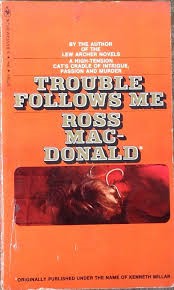TROUBLE FOLLOWS ME

“A tragedy is a representation of an action that is whole and complete and of a certain magnitude. A whole is what has a beginning and middle and end.”
–Aristotle, The Poetics
“It all stated at a little 5,000-watt station in Fresno, California.”
—-Ted Baxter, The Mary Tyler Moore Show
A SPRAWLING MYSTERY NOVEL
Ross Macdonald was the beneficiary of a literary education at a time when that implied a careful study of Classical literature, and his body of work (most obviously The Three Roads shows that he had a deep understanding of Greek literature. It is not known whether Macdonald was taught that the Aristotelian unity of time, place and action was a Renaissance invention, but Macdonald was exposed to more than enough Classical thinking to profoundly influence his work.
As his work matures, he increasingly demonstrates his understanding for the need for unity in a way Aristotle would have understood. By his late work (Sleeping Beauty comes to mind as an example) the entire novel is essential one continuous account of the actions of Lew Archer. But his tale in Trouble Follows Me does not fit neatly into the Classical ideal:
- It starts in Oahu,
- Moves to the slums of Detroit (Oahu is nicer)
- Takes a transcontinental train ride and
- Ends in Mexico.
Time intervals of varying lengths separate all but the third and fourth locations. Macdonald formally divides his book into four parts corresponding with the four locations, a device he does not use again.
How I Spent My Oahu Vacation
Macdonald has yet to display a gift for the snappy opening sentence, but his opening chapter presents all the facts necessary to present the initial mystery:
- Our narrator-hero is a US Navy ensign, Sam Drake, on survivor’s leave after the sinking of his ship, awaiting transportation to the mainland.
- Drake is with a friend, a fellow-officer, Eric Swann, at a large private club called the Honolulu House, which tries to appear as a responsible place but is an after-hours bar. Drake and Swann have known each other for some time and are both originally from Detroit. Unlike Drake, Swann has a wife back home, Helen.
- Swann has brought along his girlfriend to meet Drake, a petite woman named Sue Sholto. Sue is unabashedly Jewish and liberal.
- The fourth member of what turns into a sort of double date is Mary Thompson, tall, glamourous, and slightly mysterious. Mary and Sue know each other, both being employed as disc jockeys at a Honolulu radio station.
- The party is joined by a local journalist, Gene Halford, a war correspondent, whose role is to introduce the possibility that Japanese spies are receiving information about ship movements from Hawaii, but no one can figure out how. Hold that thought.
- The evening is rounded off by Mrs. Merriwell, a woman of a certain age and social position who after some pleasantries reveals that she is an unreconstructed racist. For the rest of the chapter, her racist views are the subject of ridicule by Sue Sholto.
- Drake and Mary Thompson begin what some would describe as tepid flirting and what Macdonald probably considered to be blatant sexual repartee.
- Sue goes upstairs to use the ladies’ room and disappears. A few minutes later she is discovered dead, hanging by a noose from an upper story window.
Any comments? Email me at dgarrett1948@ptd.net
Recent Comments